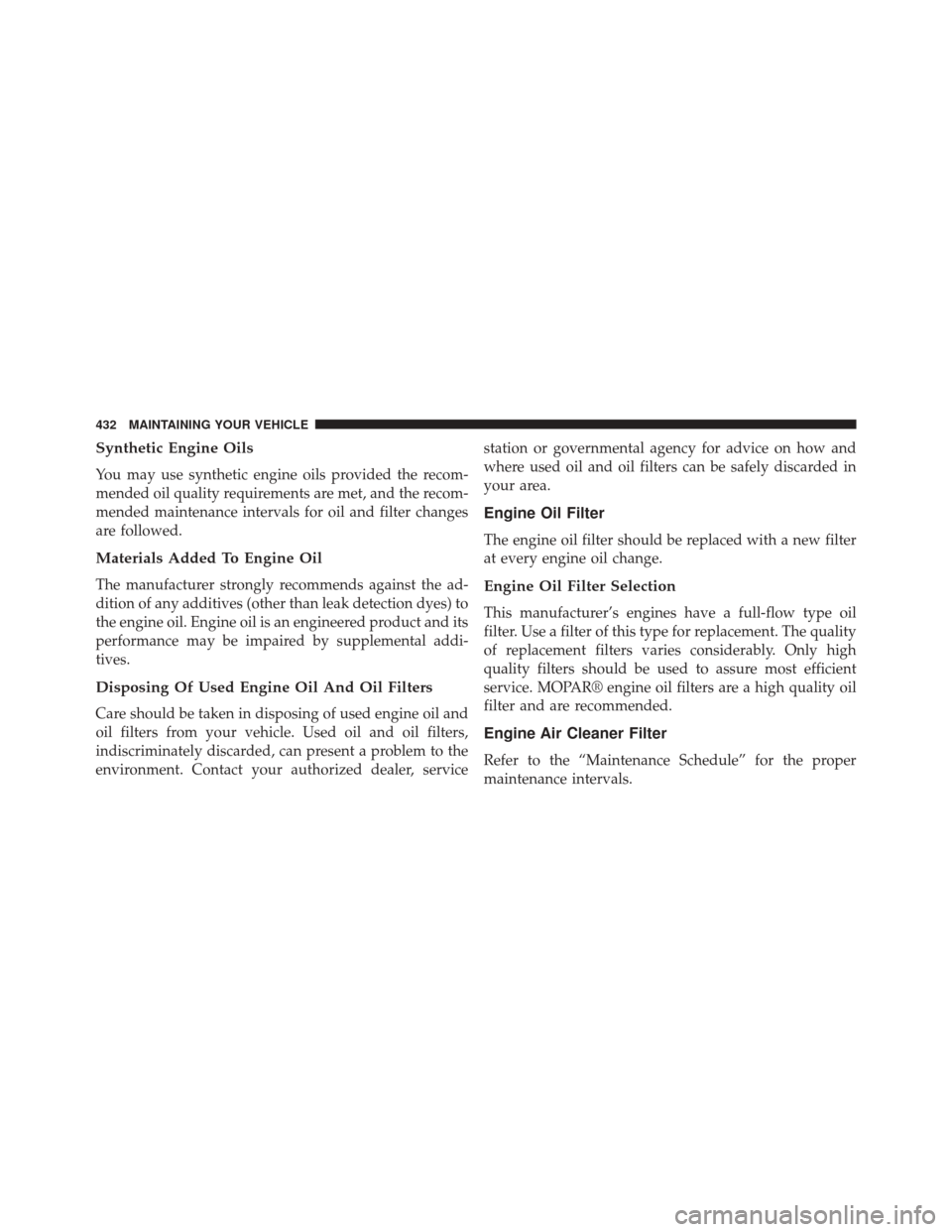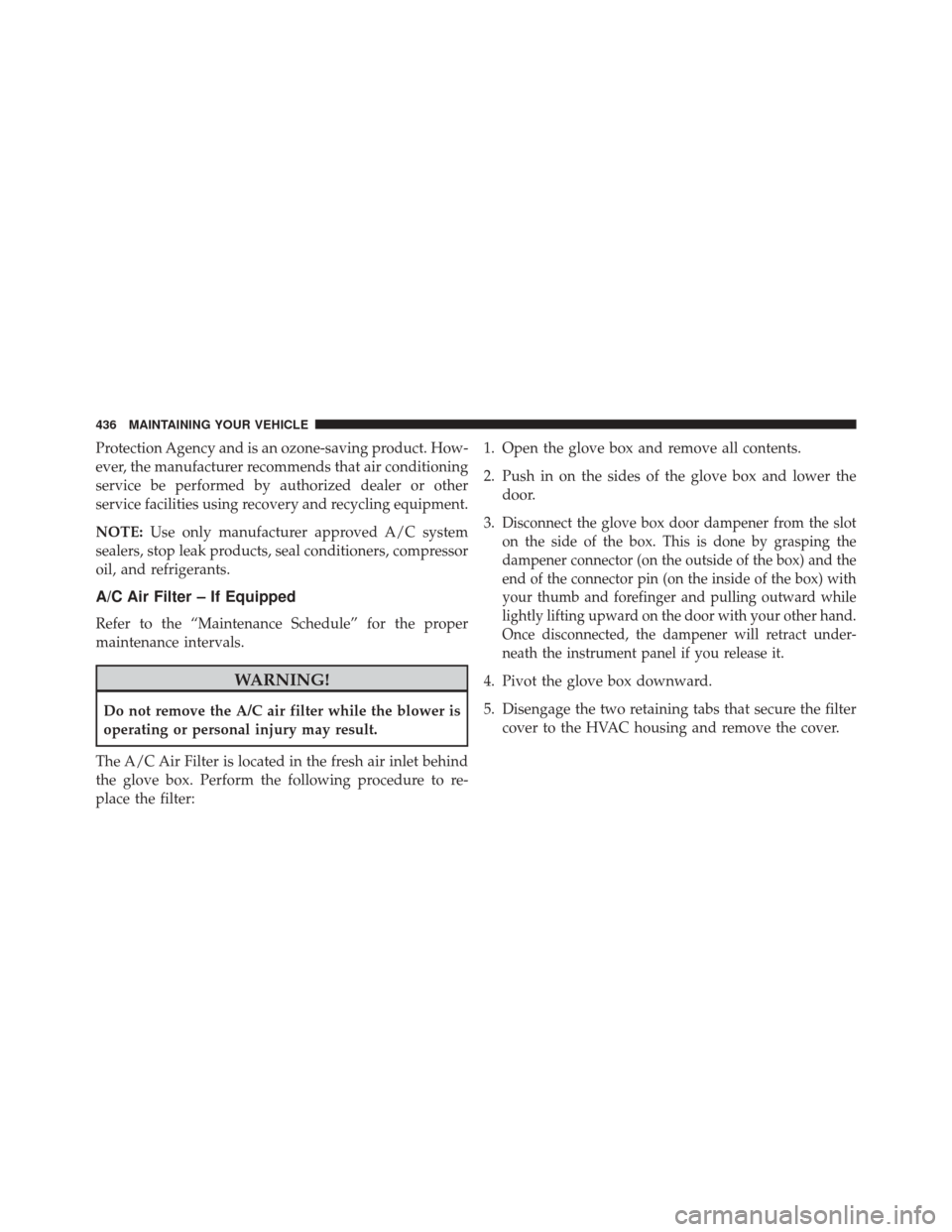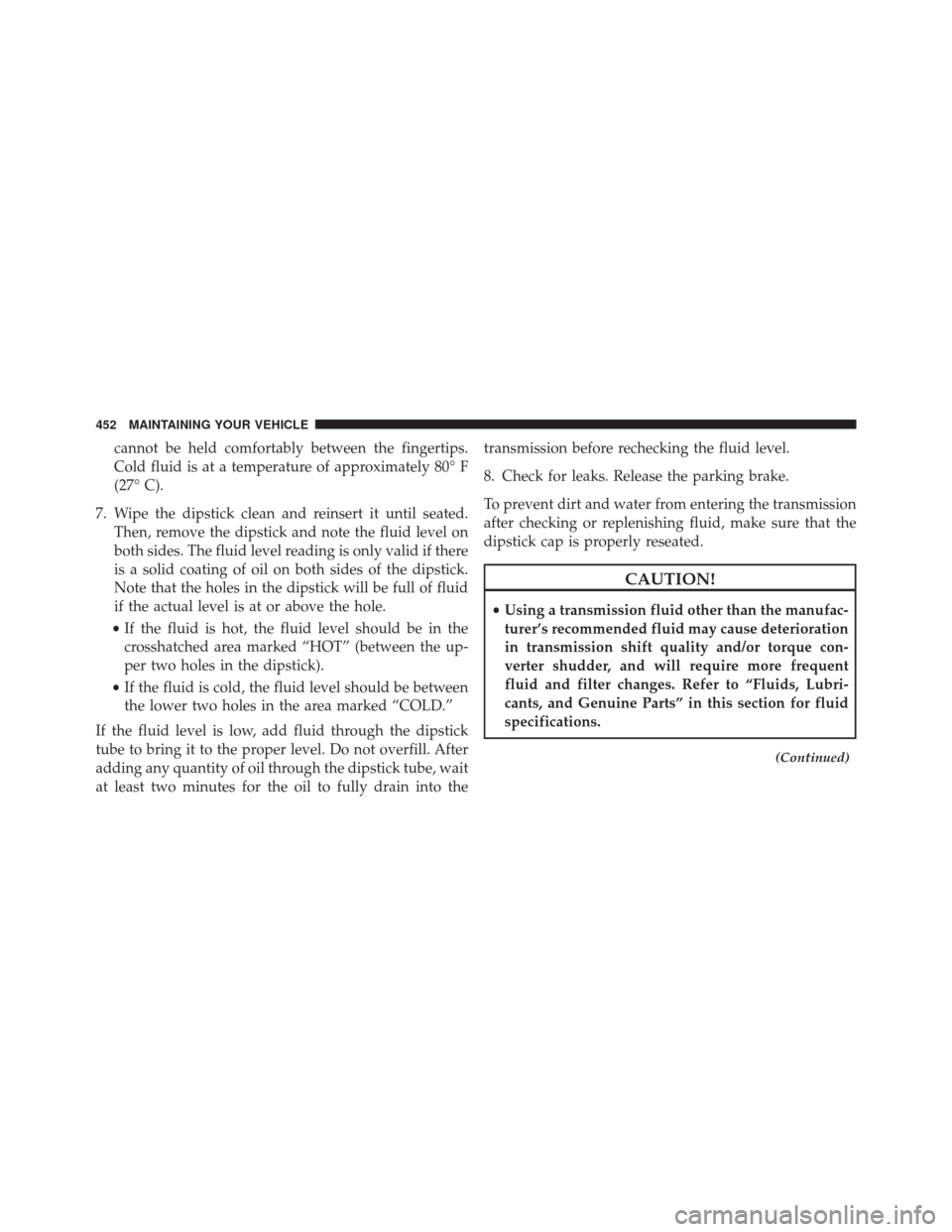Page 374 of 522

CAUTION!(Continued)
blends may result in starting and drivability prob-
lems, damage critical fuel system components, cause
emissions to exceed the applicable standard, and/or
cause the “Malfunction Indicator Light” to illumi-
nate. Pump labels should clearly communicate if a
fuel contains greater than 10% Ethanol.
Problems that result from using gasoline containing
Methanol or gasoline containing more than 10% Ethanol
are not the responsibility of the manufacturer and may
not be covered under New Vehicle Limited Warranty.
E-85 Usage In Non-Flex Fuel Vehicles
Non-Flex Fuel Vehicle (FFV) is compatible with gasoline
containing 10% ethanol (E10). Gasoline with higher etha-
nol content may void the New Vehicle Limited Warranty.
If a Non-FFV vehicle is inadvertently fueled with E-85
fuel, the engine will have some or all of these symptoms: •
Operate in a lean mode.
• OBD II “Malfunction Indicator Light” on.
• Poor engine performance.
• Poor cold start and cold drivability.
• Increased risk for fuel system component corrosion.
To fix a Non-FFV vehicle inadvertently fueled once with
E-85 perform the following:
• Drain the fuel tank (see your authorized dealer.)
• Change the engine oil and oil filter.
• Disconnect and reconnect the battery to reset the
engine controller memory.
More extensive repairs will be required for prolonged
exposure to E-85 fuel.
372 STARTING AND OPERATING
Page 423 of 522
MAINTAINING YOUR VEHICLE
CONTENTS
�ENGINE COMPARTMENT — 2.4L ..........423
� ENGINE COMPARTMENT — 3.6L ..........424
� ONBOARD DIAGNOSTIC SYSTEM — OBD II . .425
▫ Loose Fuel Filler Cap Message ............425
� EMISSIONS INSPECTION AND MAINTENANCE
PROGRAMS ......................... .426
� REPLACEMENT PARTS ..................427
� DEALER SERVICE ..................... .427
� MAINTENANCE PROCEDURES ...........428
▫ Engine Oil ......................... .429▫
Engine Oil Filter ..................... .432
▫ Engine Air Cleaner Filter ................432
▫ Maintenance-Free Battery ...............433
▫ Air Conditioner Maintenance .............435
▫ A/C Air Filter – If Equipped .............436
▫ Body Lubrication .....................437
▫ Windshield Wiper Blades ...............438
▫ Adding Washer Fluid ..................438
▫ Exhaust System ..................... .439
▫ Cooling System ..................... .442
7
Page 425 of 522
ENGINE COMPARTMENT — 2.4L
1 — Engine Coolant Reservoir5 — Integrated Power Module (Fuses) 9 — Coolant Pressure Cap
2 — Power Steering Fluid Reservoir 6 — Power Distribution Center (Fuses) 10 — Engine Oil Dipstick
3 — Automatic Transmission Dipstick 7 — Air Cleaner Filter 11 — Washer Fluid Reservoir
4 — Brake Fluid Reservoir 8 — Engine Oil Fill
7
MAINTAINING YOUR VEHICLE 423
Page 426 of 522
ENGINE COMPARTMENT — 3.6L
1 — Engine Coolant Reservoir5 — Air Cleaner Filter
2 — Power Steering Fluid Reservoir 6 — Engine Oil Dipstick
3 — Brake Fluid Reservoir 7 — Engine Oil Fill
4 — Integrated Power Module (Fuses) 8 — Washer Fluid Reservoir
424 MAINTAINING YOUR VEHICLE
Page 434 of 522

Synthetic Engine Oils
You may use synthetic engine oils provided the recom-
mended oil quality requirements are met, and the recom-
mended maintenance intervals for oil and filter changes
are followed.
Materials Added To Engine Oil
The manufacturer strongly recommends against the ad-
dition of any additives (other than leak detection dyes) to
the engine oil. Engine oil is an engineered product and its
performance may be impaired by supplemental addi-
tives.
Disposing Of Used Engine Oil And Oil Filters
Care should be taken in disposing of used engine oil and
oil filters from your vehicle. Used oil and oil filters,
indiscriminately discarded, can present a problem to the
environment. Contact your authorized dealer, servicestation or governmental agency for advice on how and
where used oil and oil filters can be safely discarded in
your area.
Engine Oil Filter
The engine oil filter should be replaced with a new filter
at every engine oil change.
Engine Oil Filter Selection
This manufacturer’s engines have a full-flow type oil
filter. Use a filter of this type for replacement. The quality
of replacement filters varies considerably. Only high
quality filters should be used to assure most efficient
service. MOPAR® engine oil filters are a high quality oil
filter and are recommended.
Engine Air Cleaner Filter
Refer to the “Maintenance Schedule” for the proper
maintenance intervals.
432 MAINTAINING YOUR VEHICLE
Page 438 of 522

Protection Agency and is an ozone-saving product. How-
ever, the manufacturer recommends that air conditioning
service be performed by authorized dealer or other
service facilities using recovery and recycling equipment.
NOTE:Use only manufacturer approved A/C system
sealers, stop leak products, seal conditioners, compressor
oil, and refrigerants.
A/C Air Filter – If Equipped
Refer to the “Maintenance Schedule” for the proper
maintenance intervals.
WARNING!
Do not remove the A/C air filter while the blower is
operating or personal injury may result.
The A/C Air Filter is located in the fresh air inlet behind
the glove box. Perform the following procedure to re-
place the filter: 1. Open the glove box and remove all contents.
2. Push in on the sides of the glove box and lower the
door.
3.
Disconnect the glove box door dampener from the slot
on the side of the box. This is done by grasping the
dampener connector (on the outside of the box) and the
end of the connector pin (on the inside of the box) with
your thumb and forefinger and pulling outward while
lightly lifting upward on the door with your other hand.
Once disconnected, the dampener will retract under-
neath the instrument panel if you release it.
4. Pivot the glove box downward.
5. Disengage the two retaining tabs that secure the filter cover to the HVAC housing and remove the cover.
436 MAINTAINING YOUR VEHICLE
Page 454 of 522

cannot be held comfortably between the fingertips.
Cold fluid is at a temperature of approximately 80° F
(27° C).
7. Wipe the dipstick clean and reinsert it until seated. Then, remove the dipstick and note the fluid level on
both sides. The fluid level reading is only valid if there
is a solid coating of oil on both sides of the dipstick.
Note that the holes in the dipstick will be full of fluid
if the actual level is at or above the hole.
• If the fluid is hot, the fluid level should be in the
crosshatched area marked “HOT” (between the up-
per two holes in the dipstick).
• If the fluid is cold, the fluid level should be between
the lower two holes in the area marked “COLD.”
If the fluid level is low, add fluid through the dipstick
tube to bring it to the proper level. Do not overfill. After
adding any quantity of oil through the dipstick tube, wait
at least two minutes for the oil to fully drain into the transmission before rechecking the fluid level.
8. Check for leaks. Release the parking brake.
To prevent dirt and water from entering the transmission
after checking or replenishing fluid, make sure that the
dipstick cap is properly reseated.
CAUTION!
•
Using a transmission fluid other than the manufac-
turer’s recommended fluid may cause deterioration
in transmission shift quality and/or torque con-
verter shudder, and will require more frequent
fluid and filter changes. Refer to “Fluids, Lubri-
cants, and Genuine Parts” in this section for fluid
specifications.
(Continued)
452 MAINTAINING YOUR VEHICLE
Page 479 of 522
4. Twist and remove socket from lamp.
5. Remove bulb from socket and replace.
6. Reinstall the tail lamp, fasteners, and trunk liner.License Plate Lamp
1. Using a small screwdriver, press inward the lockingtab on the side of the lamp assembly and pull down on
the lamp assembly for removal.
2. Pull bulb from socket, replace, and reinstall the lamp assembly into place ensuring the locking tab is secure.
FLUID CAPACITIES
U.S. Metric
Fuel (Approximate)
All Engines — (Except 2.4L PZEV) 16.9 Gallons64 Liters
2.4L PZEV (Partial Zero Emissions Vehicle) 18.5 Gallons70 Liters
Engine Oil With Filter
2.4L Engine (SAE 5W-20, API Certified) 4.5 Quarts4.26 Liters
3.6L Engine (SAE 5W-20, API Certified) 6 Quarts5.6 Liters
7
MAINTAINING YOUR VEHICLE 477